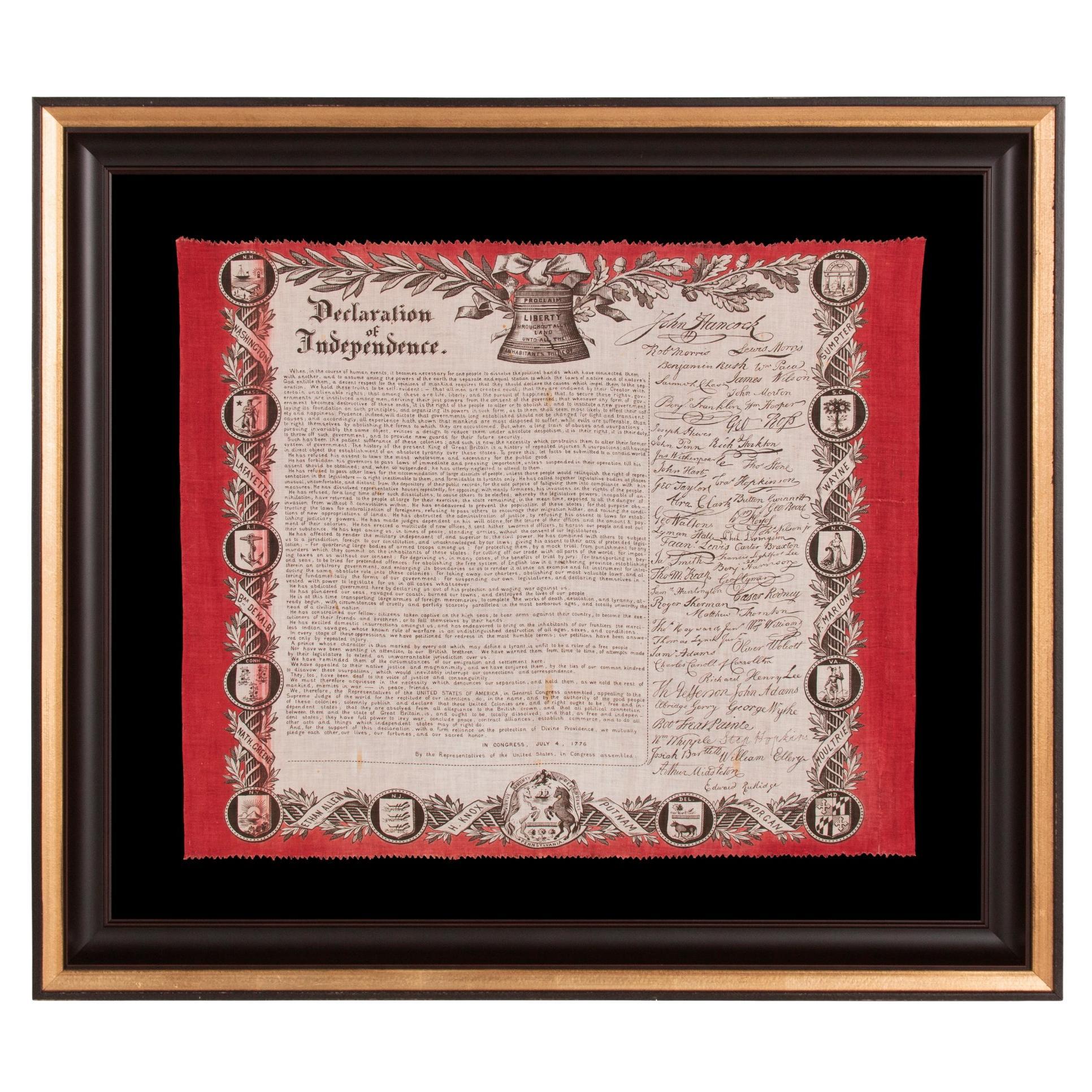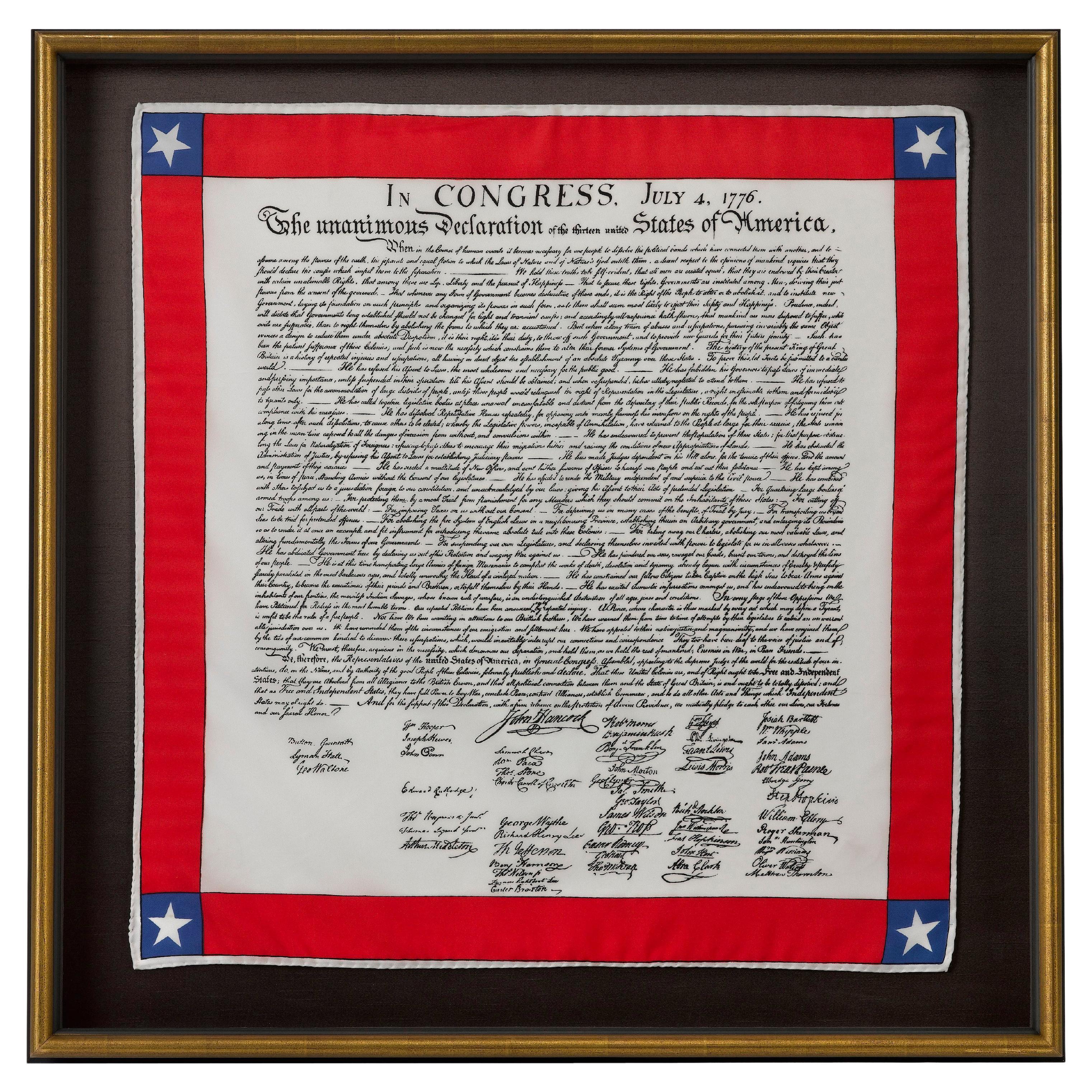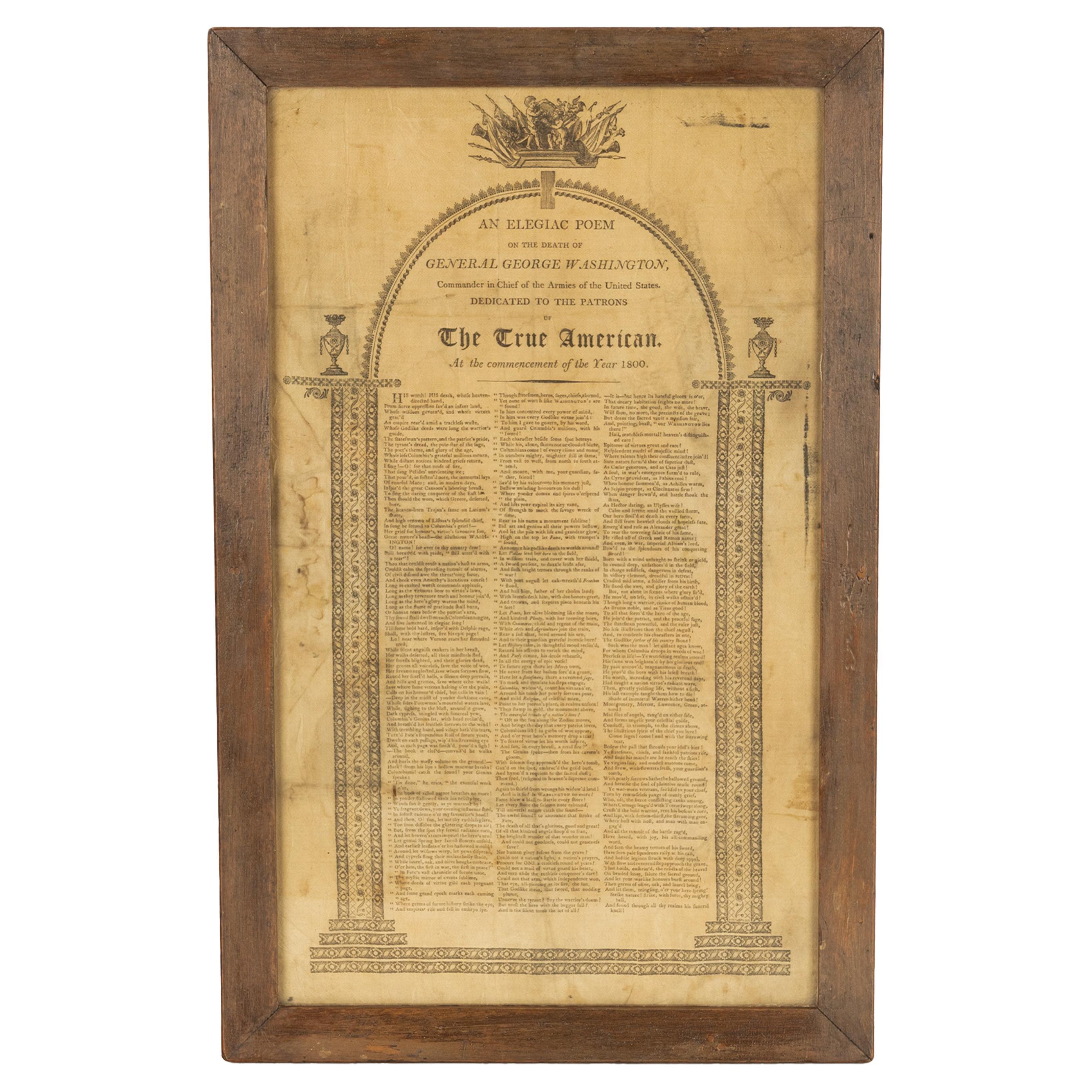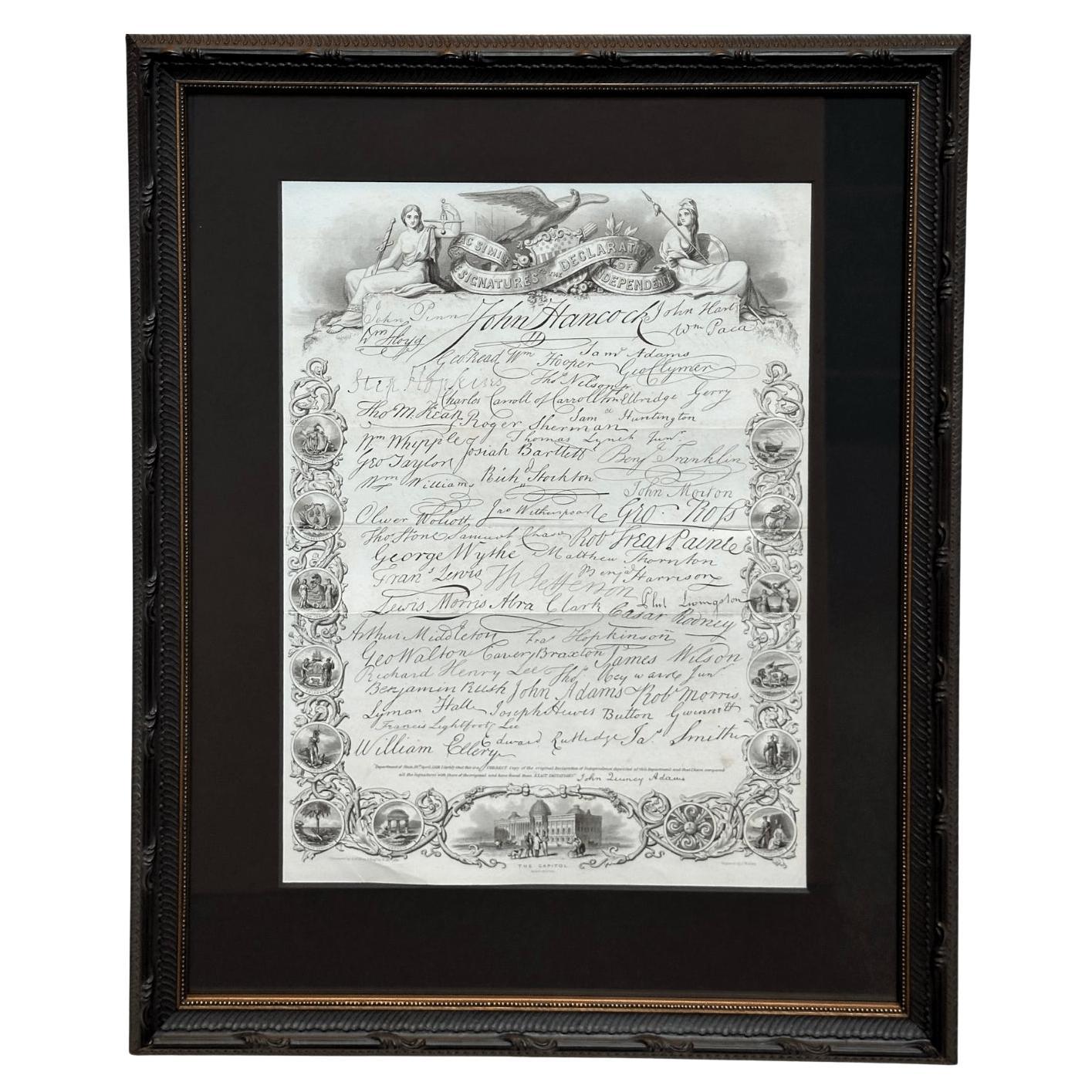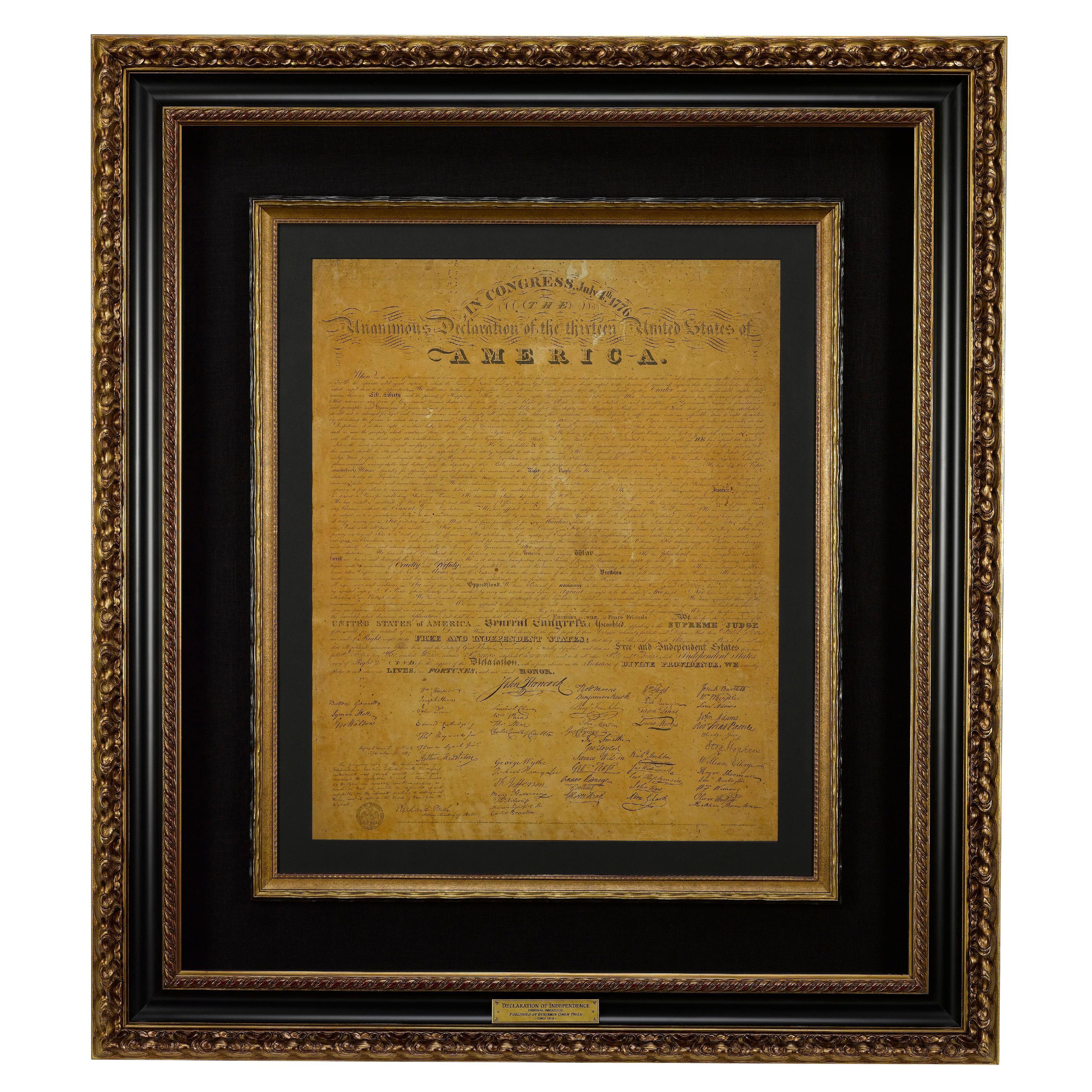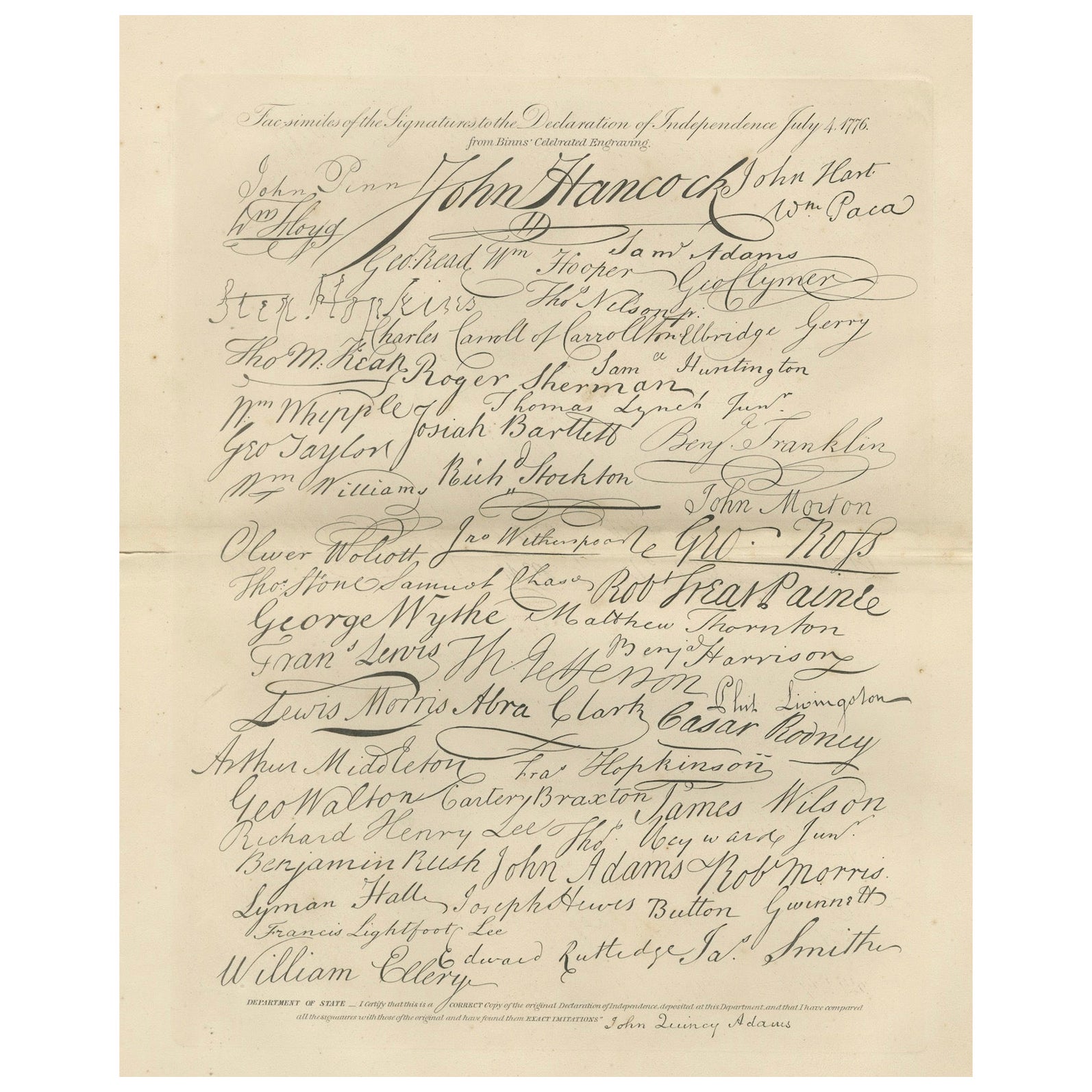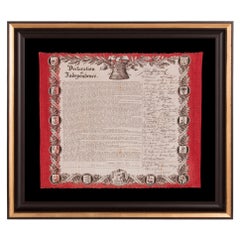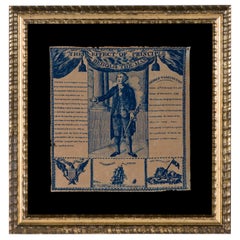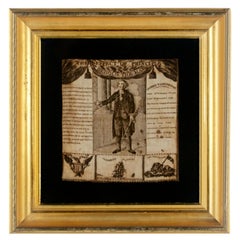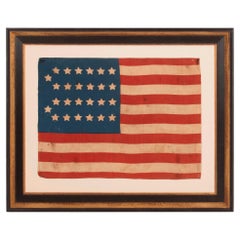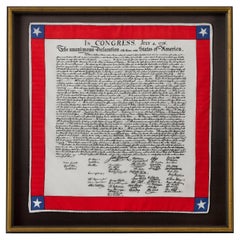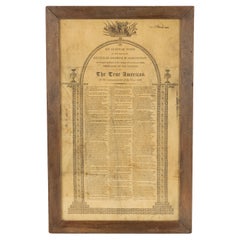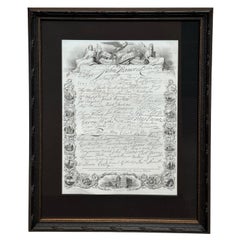Items Similar to Declaration of Independence on Cloth, Printed in Boston 1832
Want more images or videos?
Request additional images or videos from the seller
1 of 9
Declaration of Independence on Cloth, Printed in Boston 1832
Price Upon Request
Price Upon Request
Price Upon Request
Price Upon Request
Price Upon Request
Price Upon Request
Price Upon Request
Price Upon Request
Price Upon Request
Price Upon Request
About the Item
COPY OF THE DECLARATION OF INDEPENDENCE ON CLOTH, PRINTED IN BOSTON IN 1832 TO MEMORIALIZE THE PASSING OF THE LAST SURVIVING SIGNER, CHARLES CARROLL OF MARYLAND, IN THE YEAR THAT COINCIDED WITH THE 100th BIRTHDAY OF GEORGE WASHINGTON
This printing of the Declaration of Independence, rendered in black ink on cotton, was produced in Massachusetts by the Boston Chemical Printing Company in 1832. Along the top register, within a border of conjoined rings, is an eagle in flight, carrying a streamer with the familiar Latin phrase “E Pluribus Unum” (out of many, one). This is flanked by fanciful wreaths of sea shells, flora & fauna, containing the words “In Congress July 4th, 1776” and “Of the Thirteen United States of America.”
1832 was the year that marked the celebration of Washington’s 100th birthday, which was widely celebrated. The reason for the making of this textile seems to have had dual purpose, however, which is revealed in the text that follows that of the document and its signers. Included are a letter from John Adams on July 5th, 1776, announcing that the Declaration had been signed, plus the date of the signing of the treaty and the end of the Revolutionary War (1783, ratified 1784), the date of the Constitutional Convention (1787), and that of the first congress to meet following the adoption of the Constitution (1789). This is followed by a list of states that had thus-far joined the Union, and a list of presidents and the dates that they served. Next is a discussion of the deaths of Adams and Jefferson, who passed on the same day, July 4th, 1826, exactly 50 years after July 4th, 1776, and a note of honor regarding the 1831 death of James Monroe. At the end, the text gives honor to the last surviving signer, Charles Carroll of Maryland, who passed in 1832. This copy of the document and related historical information seems to have been printed to remember Carroll and the others whose deaths preceded him.
The text appears in columns, like a newspaper. The name of the maker appears in the bottom center in the following manner: “Henry Bowen’s Chemical Print, 19 Water-Street, Boston.”
Note that the date Andrew Jackson would leave office was presumptuously added, five years in advance of the actual. Reelected in 1832, he would serve another 4 years., as he was re-elected in 1832. Arkansas would become the 25th state in 1836, followed by Michigan in 1837.
It is of interest to note that prior to 1818, just 14 years before this textile was produced, Americans were not even able to view copies of the Declaration of Independence. The text had been published in some newspapers during the 18th century, but at the time it was more of a tool to achieve independence and not precisely the iconic treasure that it would become. Prior to that time there were no large-scale, printed copies that reproduced the actual document or any representation thereof.
Benjamin Owen Tyler of Philadelphia became the first to publish an engraved rendition, which he released in 1818. Printed on parchment, velum, linen and silk, this appeared in a simple, unembellished style, without pictorial imagery. Almost all were printed on parchment. Today just four of Tyler's engravings are estimated to survive that are printed on cloth. This is actually a fairly remarkable number, because, according to Declaration expert Seth Kaller, only 6 may have ever been ordered. Tyler's original ledger book is among the holdings of the University of Virginia, where it is part of the Albert H. Small Declaration of Independence Collection. Having had the opportunity to pour through the book to compile data, Kaller counted "roughly 1,694 copies sold on paper, 40 on vellum, 3 on silk, and 3 on linen."
Very few copies were rendered on cloth in early America, which is one of the reasons why this copy is important. Besides the 6 copies produced by Tyler, a version is known that was produced on silk by H. Brunet in Lyon, France between roughly 1820 and 1825. Another was produced in three different styles (extremely similar) by a dual-citizenship Scott and American, by the name of Collin Gillespie, produced copies in Scotland for the American market in 1821.
It is of interest to note that the first identical copies of the Declaration of Independence (on parchment) were not made until 1823. With the fifty-year anniversary of the document at hand, fear of the degradation of the original caused John Quincy Adams to seek out the services of William J. Stone of Washington, D.C., who soaked the original in order to make a copperplate engraving. Stone then printed a copy on rice paper for each state and each surviving signer. It was not copied again until 1843, when the Stone plate was allowed to be used by Peter Force for another printing that was inserted in a book.
Mounting: The exceptional, veneered, bird’s eye maple frame, with its wide, beveled profile, dates to the 1830’s and is of English origin. The textile has been hand-stitched to a background of 100% cotton twill, black in color, that has been washed and treated for color-fastness. The glazing is U.V. protective acrylic (Plexiglas).
Condition: There is moderate to significant fading. There are two minor to moderate areas of loss, including one in the first column of text, near the bottom, and one between the 3rd and 4th columns, accompanied by a scattering of extremely minor losses elsewhere, in limited areas. Fabric of similar coloration was placed behind the textile during the mounting process. The early date and the rarity of the textile well-warrant its present state of preservation.
Frame Size (H x L): 27.75" x 27.25"
Flag Size (H x L): 17.5" x 18.5"
- Dimensions:Height: 27.75 in (70.49 cm)Width: 27.25 in (69.22 cm)Depth: 2 in (5.08 cm)
- Materials and Techniques:
- Place of Origin:
- Period:1830-1839
- Date of Manufacture:1832
- Condition:See Item Description.
- Seller Location:York County, PA
- Reference Number:Seller: pat-7381stDibs: LU849740600142
About the Seller
5.0
Recognized Seller
These prestigious sellers are industry leaders and represent the highest echelon for item quality and design.
Established in 1991
1stDibs seller since 2008
70 sales on 1stDibs
Typical response time: 12 hours
- ShippingRetrieving quote...Shipping from: York County, PA
- Return Policy
Authenticity Guarantee
In the unlikely event there’s an issue with an item’s authenticity, contact us within 1 year for a full refund. DetailsMoney-Back Guarantee
If your item is not as described, is damaged in transit, or does not arrive, contact us within 7 days for a full refund. Details24-Hour Cancellation
You have a 24-hour grace period in which to reconsider your purchase, with no questions asked.Vetted Professional Sellers
Our world-class sellers must adhere to strict standards for service and quality, maintaining the integrity of our listings.Price-Match Guarantee
If you find that a seller listed the same item for a lower price elsewhere, we’ll match it.Trusted Global Delivery
Our best-in-class carrier network provides specialized shipping options worldwide, including custom delivery.More From This Seller
View AllThe Declaration of Independence, Printed on Cotton, ca 1876
Located in York County, PA
PRINTED COTTON KERCHIEF GLORIFYING THE DECLARATION OF INDEPENDENCE, WITH TEXT AND REPRODUCED SIGNATURES, MADE FOR THE 1876 CENTENNIAL INTERNATIONAL EXPOSITION IN PHILADELPHIA
Printed on cotton, this beautiful kerchief pays homage to the Declaration of Independence, through the reproduction of its text and 56 signatures, surrounded by a fanciful border. The latter contains the 13 state seals, which are dispersed around the perimeter in small medallion images. Note how Pennsylvania is highlighted among them, larger and in the bottom center, both because it served as the meeting place of the Second Continental Congress, and played host to the 1876 Centennial International Exposition, the six-month long World’s Fair event that was held in honor of our nation’s 100-year anniversary of independence.
The names of twelve Revolutionary War generals are spread out between each crest, on each forward-facing turn of a scroll, that wraps around the pillar and leaf border on the right, left, and bottom. These include Washington, Lafayette, Johann de Kalb, Nathiel Greene, Ethan Allen, Henry Knox, Israel Putnam, Daniel Morgan, William Moultrie, Francis Marion...
Category
Antique Late 19th Century American Political and Patriotic Memorabilia
Materials
Cotton
Price Upon Request
1806 Printed Linen Kerchief Glorifying George Washington, Germantown, Penn
Located in York County, PA
EXTRAORDINARILY EARLY (1806) PRINTED LINEN KERCHIEF GLORIFYING GEORGE WASHINGTON, PRINT WORKS, GERMANTOWN, PENNSYLVANIA
Printed in blue ink on coarse, white linen, this patriotic kerchief shows a standing portrait of George Washington, above which is a swag valance and the words “The Effect of Principle, Behold the Man”. The portrait is based on a mezzotint after Gilbert Stuart’s very famous painting of Washington in his later years, most often referred to as the Landsdowne portrait. Stuart painted three versions of it in oil on canvas, one of which was completed in 1796 for a wealthy merchant by the name of William Constable, who commissioned the work for Alexander Hamilton.
The kerchief is interesting because it is both American-made and documented. This is exceptionally unusual for any printed textile of the 19th century or prior and the earlier the time period the more unlikely an object is to be identified. This kerchief and a companion piece entitled “The Love of Truth Mark the Boy” (also glorifying Washington, through the fabled story of the cherry tree), were made circa 1806 by Germantown Print Works in Germantown, Pennsylvania.
To the left of Washington's image is a portion of his infamous farewell address to his troops at the end of the Revolutionary War. To the right is a short excerpt from his eulogy. Below these are three images. In the center is a square-rigged tall ship with “Commercial Union” above it, flanked by the American eagle on the left and the British lion on the right. It is reasonable to assume that the textile may have been produced in demonstration of the maker's desire, and/or that of others, to advance trade with England. Commercial printers were very influential in early America, as they possessed the means by which to disseminate information.
This kerchief and its companion piece are documented in Threads of History, Americana Recorded on Cloth, 1775 - the Present, by Herbert Ridgeway Collins (1979, Smithsonian Press), p. 63, items 38 & 39.* The two pieces pictured are in the collection of Cornell University, but the Collins text also cites an uncut pair to be present in the collection of the Western Reserve Historical Society, Cleveland, OH. The name "Germantown Print Works" is printed on the Western Reserve examples. Another example of the textile in question is documented in "Running for President, The Candidates and Their Images, 1789-1896" by Schlesinger, Israel, and Frendt, (1994, Simon & Schuster), p. 15.
I have seen three different color variations of this textile, including sepia, mulberry red, and blue. This particular example has a hand-sewn binding along the top, lower, and left edges.
Mounting: The textile was mounted and framed within our own conservation department, which is led by expert staff. We take great care in the mounting and preservation of flags and have framed thousands of examples.
The gilded molding has a rippled profile and dates to the period between 1825 and 1850.The background is 100% cotton twill, black in color. The glazing is U.V. protective plexiglass. Feel free to contact us for more details.
Condition: There is an all-over golden oxidation of the white fabric and there is very minor staining. There are tiny tack holes in each corner and there are minor nicks around the perimeter.
* Collins relates that Germantown Printworks was operated by the Hewsons. In doing so he cites one of Worthington Chauncey Ford's books on George Washington, but it isn't clear which one (there are many) and no page numbers are given. John Hewson was an Englishman who came to America and opened his printing business on the advice of Benjamin Franklin. He was one of the first “calico printers” and is the earliest documented to have advertised printed kerchiefs. His ads for bandanas appear as early as June 20th, 1774. He is suspected of having produced the very first American kerchief that pictured an American president, which is documented in Collins as item 1 on page 48. Linda Eaton, curator at Winterthur, in 2012, is currently doing in depth research on the three printers of fabrics that were operating in Germantown in early America. She discovered that the owner and/or operator of Germantown Print Works, while not currently known, was not John Hewson. This information is not yet published. She also noted that Winterthur possessed examples of the two George Washington textiles...
Category
Antique Early 1800s American Political and Patriotic Memorabilia
Materials
Cotton
Printed Linen Kerchief of George Washington, ca 1806, Germantown, PA
Located in York County, PA
Extraordinarily early (1806) printed linen kerchief glorifying George Washington, Germantown print works, Germantown, Pennsylvania
Printed in sepia ink on coarse, white linen, this patriotic kerchief shows a standing portrait of George Washington, above which is a swag valance and the words “The Effect of Principle, Behold the Man”. The portrait is based on a mezzotint after Gilbert Stuart’s very famous painting of Washington in his later years. Stuart painted it in oil on canvas for a wealthy merchant by the name of William Constable, who commissioned the work for Alexander Hamilton.
The kerchief is interesting because it is both American-made and documented. This is exceptionally unusual for any printed textile of the 19th century or prior and the earlier the time period the more unlikely an object is to be identified. This kerchief and a companion piece entitled “The Love of Truth Mark the Boy” (also glorifying Washington through the fabled story of the cherry tree), were made ca 1806 by Germantown Print Works in Germantown, Pennsylvania.
To the left of Washington's image is a portion of his infamous farewell address to his troops at the end of the Revolutionary War. To the right is a short excerpt from his eulogy. Below these are three images. In the center is a square-rigged tall ship with “Commercial Union” above it, flanked by the American eagle on the left and the British lion...
Category
Antique Early 19th Century American Political and Patriotic Memorabilia
Materials
Linen
26 Star Antique American Flag, with 11 Stripes, Michigan Statehood, ca 1837-1846
Located in York County, PA
26 STAR ANTIQUE AMERICAN PARADE FLAG WITH 11 STRIPES AND IT’S CANTON RESTING ON THE “WAR STRIPE.” THE EARLIEST KNOWN STAR COUNT FOR PRINTED EXAMPLES, 1837-1846, MICHIGAN STATEHOOD
2...
Category
Antique Mid-19th Century American Political and Patriotic Memorabilia
Materials
Cotton
30 Star Antique American Parade Flag, Wisconsin Statehood, ca 1848-1850
Located in York County, PA
ANTIQUE AMERICAN PARADE FLAG WITH 30 STARS, THE ONLY KNOWN EXAMPLE IN THIS SIMPLE BUT EXTRAORDINARY STYLE, PRE-CIVIL WAR, OFFICIAL FOR JUST TWO YEARS, REFLECTS THE ADDITION OF WISCON...
Category
Antique Mid-19th Century American Political and Patriotic Memorabilia
Materials
Cotton
Price Upon Request
36 Star Antique American Parade Flag, with Canted Stars, ca 1864-1867
Located in York County, PA
36 STAR ANTIQUE AMERICAN PARADE FLAG WITH CANTED STARS IN DANCING ROWS, ON A BEAUTIFUL, CORNFLOWER BLUE CANTON; CIVIL WAR ERA, NEVADA STATEHOOD, 1864-1867
36 star antique American f...
Category
Antique 1860s American Political and Patriotic Memorabilia
Materials
Cotton
Price Upon Request
You May Also Like
Declaration of Independence Printed Scarf
Located in Colorado Springs, CO
Presented is a patriotic silk scarf, celebrating the Declaration of Independence. At center of the silk scarf design is artistic rendering of the Declaration of Independence. The famous text and signatures are printed in black ink on white silk. A border of bright red encloses the text, with a five-pointed white star set against a blue square appearing at each corner. This is a newly made silk scarf, printed to celebrate our Nation's foundational text.
The United States Declaration of Independence...
Category
21st Century and Contemporary American Tapestries
Materials
Silk
Antique Silk Broadside An Elegiac Poem Death of President George Washington 1800
Located in Portland, OR
An important & rare antique American political printed silk broadside, an elegy on the death of President George Washington, dated 1800.
A poem on the Death of President George Was...
Category
Antique 1790s Federal Political and Patriotic Memorabilia
Materials
Silk
"Facsimile of the Signatures to the Declaration of Independence" by A.H. Wray
Located in Colorado Springs, CO
Presented is a handsome steel engraving, a patriotic composition of the facsimile signatures of the signers of the Declaration of Independence. The engraving is from John H. Hinton’...
Category
Antique 1850s American Federal Prints
Materials
Paper
1818 Declaration of Independence Broadside Engraved by Benjamin Owen Tyler
Located in Colorado Springs, CO
This is a stunning 1818 engraving of the Declaration of Independence, the first engraved broadside of our nation’s founding document. The year 1815 saw the conclusion of the United S...
Category
Antique 1810s American Federal Prints
Materials
Paper
Declaration of Independence Signatures Facsimile – Binns Engraving, 1850s
Located in Langweer, NL
Declaration of Independence Signatures Facsimile – Binns Engraving, 1820s
This antique facsimile presents the signatures of the signers of the Declaration of Independence, July 4, 1...
Category
Antique 1850s Prints
Materials
Paper
Centennial Celebration "1776-1876" American Flag Banner
Located in Colorado Springs, CO
Presented is a rare Centennial patriotic flag banner, dating to 1876. The flag’s brilliant blue canton is spectacular, with 81 five-pointed, rayed stars, arranged to read “1776” and “1876.” The flag’s design is completed with thirteen alternating red and white stripes. The flag is a three-piece, treadle-sewn sewn construction, printed on a thin wool and cotton blend. Along the edge, there is a narrow, treadle-sewn sleeve made of cotton tape.
In the lead up to the nation’s Centennial in 1876, flag makers and individuals looked to the past for designs to produce as part of the country’s many celebrations. Popular interpretation of the stars and stripes undoubtedly reached its climax of variety and originality at the time of our Nation’s first Centennial. Since no design restrictions were placed on flagmaker’s imaginations and no strict distinctions were drawn between official and unofficial star counts, it is no surprise that, on the occasion of the Centennial, creativity in flag design was not the exception, but the rule.
The cantons from this period presented an array of geometric abstractions. Great star patterns, referred to as the “starry flower of Liberty” by Oliver Wendell Holmes, that were popular from 1818 and on, resurfaced in Centennial flags...
Category
Antique 1870s American Political and Patriotic Memorabilia
Materials
Wool, Cotton
More Ways To Browse
Antique Boston
Used Furniture In Boston
4th Of July
Revolutionary War Antique
Small American Flag
18th Century Art Tools
Boston Furniture Makers
Birds Eye Maple Frame
Sea Shell Frame
Philadelphia 18th Century Furniture
John Register
Used Furniture In Arkansas
Eagle And Flag
Letter L Ring
Antique Memorial Rings
Letter C Ring
18th Century Virginia
Letter Scales
